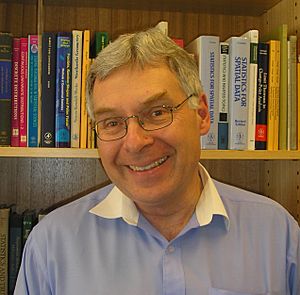Peter Gavin Hall facts for kids
Quick facts for kids
Peter Hall
|
|
|---|---|

Peter Hall in his office at The University of Melbourne in 2007
|
|
| Born |
Peter Gavin Hall
20 November 1951 Sydney
|
| Died | 9 January 2016 (aged 64) |
| Nationality | Australian |
| Alma mater | University of Sydney Australian National University University of Oxford (DPhil) |
| Awards | Australian Laureate Fellowship (2011) Guy Medal (2011) George Szekeres Medal (2010) Rollo Davidson Prize (1986) |
| Scientific career | |
| Fields | Mathematics Statistics |
| Institutions | Australian National University University of California Davis University of Melbourne |
| Thesis | Some problems in limit theory for stochastic processes and sums of random variables (1976) |
| Doctoral advisor | John Kingman |
Peter Gavin Hall (20 November 1951 – 9 January 2016) was an Australian expert in probability theory and mathematical statistics. These are types of mathematics that help us understand chance and data. The American Statistical Association said he was one of the most important and active statisticians ever.
A building at The University of Melbourne was named the Peter Hall building in his honour. This happened on 9 December 2016.
Contents
Early Life and School
Peter Hall went to Sydney Technical High School in Bexley, NSW. He studied there from 1964 to 1969. He always did very well in his exams. In his last year, he was one of the best students. He also won the Old Boys' Union Mathematics prize.
He later earned his Doctor of Philosophy degree. This was at the University of Oxford in 1976. His research was guided by John Kingman.
His Work and Discoveries
Peter Hall wrote many important papers and books. These were all about probability and statistics. By 2016, he had published over 600 works. He was known for his work in nonparametric statistics. This is a way to analyze data without making assumptions about it.
He helped develop methods like the bootstrap method. This method uses computers to estimate how accurate something is. He also worked on smoothing and density estimation. These methods help to find patterns in data. His work was used in many areas. These included economics, engineering, and science.
Peter Hall also studied how rough surfaces are. He used fractals to measure this. In probability, he made big steps in understanding chance. He also studied spatial processes and stochastic geometry. These look at random shapes and patterns. His paper "Theoretical comparison of bootstrap confidence intervals" was very important. It was even reprinted in a special collection of breakthroughs in statistics.
He worked at the School of Mathematics and Statistics. This was at the University of Melbourne. He also worked at University of California Davis. Before that, he was a professor at the Australian National University. He was one of the most cited researchers in his field. This means many other scientists used his work.
Awards and Special Recognitions
Peter Hall received many awards for his amazing work. Some of these include:
- 2015: Fellow of the Academy of Social Sciences in Australia
- 2013: Foreign Associate, National Academy of Sciences
- 2013: Officer of the Order of Australia
- 2012: Wilks Memorial Award
- 2011: Australian Laureate Fellowship
- 2011: Guy Medal in Silver
- 2010: George Szekeres Medal
- 2009: Honorary Doctor of Science degree from The University of Sydney
- 2007: Matthew Flinders Medal and Lecture
- 2000: Elected a Fellow of the Royal Society (FRS)
- 1996: Fellow of the American Statistical Association
- 1994: Hannan Medal of the Australian Academy of Science
- 1990: Pitman Medal from the Statistical Society of Australia
- 1989: Committee of presidents of Statistical Societies Award
- 1987: Fellow of the Australian Academy of Science
- 1986: Rollo Davidson Prize, University of Cambridge
- 1986: Australian Mathematical Society Medal
- 1986: Edgeworth David Medal, Royal Society of New South Wales
- 1984: Fellow of Institute of Mathematical Statistics
Books He Wrote
Peter Hall also wrote several books. These books helped others learn about his ideas.
- P. Hall; C.C. Heyde (1980): Martingale Limit Theory and its Application
- P. Hall (1982): Rates of Convergence in the Central Limit Theorem
- P. Hall (1988): Introduction to the Theory of Coverage Processes
- P. Hall (1992): The Bootstrap and Edgeworth Expansion
About His Life
Peter Hall was born to Ruby Payne-Scott and William Holman Hall. His mother was a pioneer in radiophysics and radio astronomy. His younger sister is Fiona Margaret Hall, a famous artist.
Peter Hall loved photography, especially taking pictures of trains. He also enjoyed traveling. He visited many universities around the world. He passed away from leukaemia in Melbourne on 9 January 2016. His wife, Jeannie, survived him.

